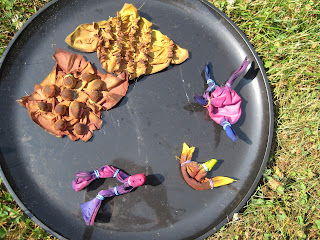I like to knead at least 3 colors together. It gives an added depth to the leaf. Here I've used a light and dark blue with some silver.
**********************************************************************************
Be sure to place the leaf vein side down on the fibers.
There should be extra fibers poking out from the edges of the leaf. You want to make the fiber pile as even as possible in thickness. I go for pretty fluffy all the way around but experience will teach you what is too thick and too thin.
***********************************************************************************
Be sure to always slide the iron over the parchment sandwich. Never let it sit on top of the fibers. You will burn them. Flip the sandwich over and repeat the ironing on the reverse side.
***********************************************************************************
Here is the leaf ironed over the fibers. Carefully pick up the leaf and bonded fibers and check for thin places in the fibers. If there is a thin place, add a little bit of the angelina fibers to it, replace the parchment paper and iron again.
***********************************************************************************
Now, carefully trim the excess fibers from around the leaf. The leaf will not be bonded to the fibers so you may have to pin it in place. Normally, I just hold the leaf in place while I trim around it.
Sorry for the fuzzy photo. I haven't figured out how to trim and take a picture at the same time.
***********************************************************************************
The angelina leaf is now ready to be used as an applique on your art quilt or clothing, or made into a curly leaf using Tyvek ( more on that when I get someone to take photos of the process).
Silk leaves and leaf patterns made out of freezer paper can also be used if you do not have a ready supply of natural leaves or there is 2 feet of snow on the ground ;-)
Of course, you can make all kinds of patterns using freezer paper - fish, dragonflys, butterflies, flower petals - just let your imagination go.
One more thing to remember. Save the pieces of bonded fibers that were trimmed away from around the leaf. They can be teased apart and used again or cut into pieces and bonded to other angelina scraps.
***********************************************************************************
SUMMER"S GLORY 2008
For more information on using these wonderful fibers and to purchase them, go to:
http://www.embellishmentvillage.com/store.php?cat=3















































